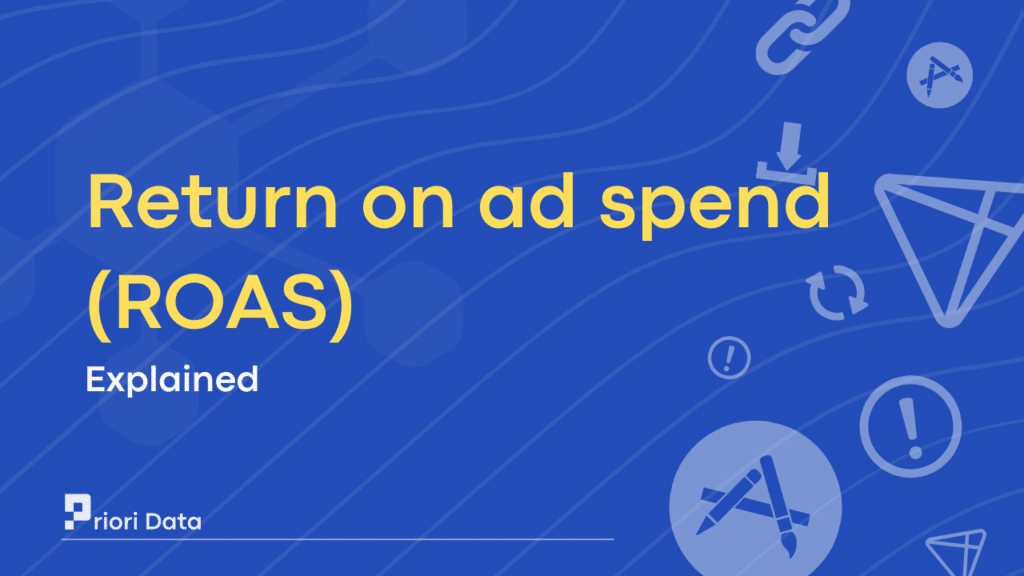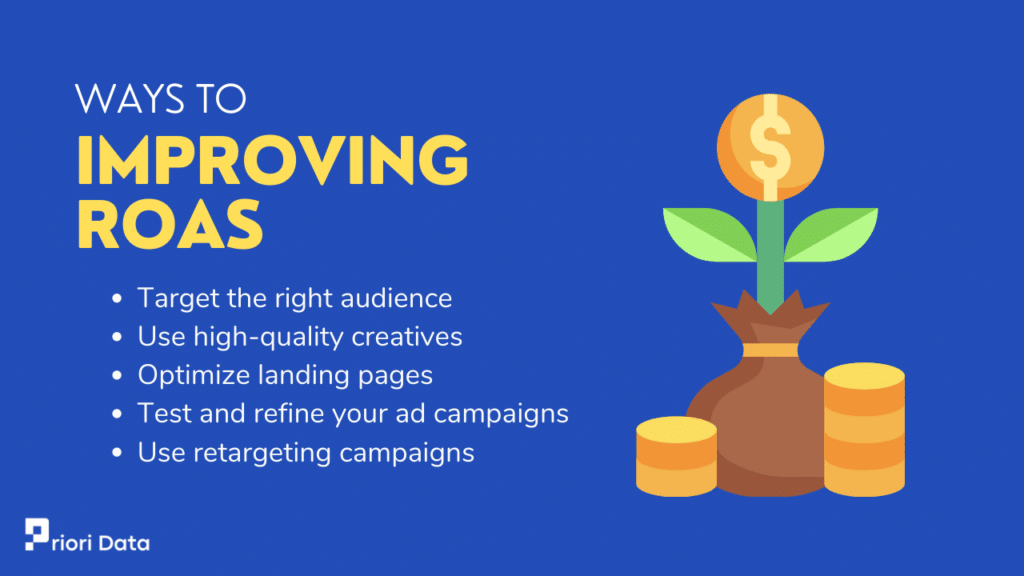Return on ad spend (ROAS) is a marketing metric used to measure the success of online campaigns.
It implies that income that’s generated for every dollar spent on advertising. ROAS plays a critical role in the world of online advertising. As it helps to measure the efficacy and the return on investment (ROI) of ad campaigns.
A ratio of the revenue produced to the amount of money spent on ad campaigns also known as ROAS. In other words, it is a method of calculating the return on investment (ROI) for an ad campaign. The campaign can perform well when the ROAS is higher.
ROAS is important in the world of digital advertising because we can track and measure it. Businesses can track how many clicks, and conversions they receive from their ads. We can use this data to calculate the ROAS for the campaign.

Calculation of return on ad spend (ROAS)
We can calculate ROAS by the ratio of revenue generated to the amount of money spent on that campaign.
ROAS = Revenue Generated / Ad Spend
For example, if a business spent $1,000 on an ad campaign and generated $6,500 in revenue, the ROAS would be 6.5.
Using the above formula:
ROAS = $6,500 / $1,000
ROAS = 6.5
The business makes $6.5 in profit for every dollar it invests in its advertising effort. If your ROAS is higher it means that your advertising campaign is successful. It results in earning more revenue for each dollar spent on advertising.
There are various methods to determine the cost of ads. You can track each dollar amount spent on campaigns that may include extra costs like:
Vendor costs
This can be fees and commissions associated with third-party vendors for ad campaigns. For example, an advertiser might work with an ad agency to create and manage their ad campaign. It pays a percentage of its ad spend as a commission to the vendor.
Affiliate costs
It refers to the expenses associated with running an affiliate marketing program. Businesses pay affiliates to promote their products and to drive sales to their app. This is the amount paid to affiliates for every sale or lead they generate for the business. These costs can vary depending on the business of its affiliate program.
ROAS calculation can be beneficial for two categories:
One that relies on ad costs, and another including extra ad expenses. This approach provides a clear understanding of the digital campaign’s profitability.
Importance of ROAS
ROAS provides insight to businesses for the effectiveness of their advertising campaigns. Businesses can determine which campaigns are performing well and not well by ROAS. We can use this information for optimizing future campaigns.
We can compare the success of different advertising channels by ROAS. Let’s see an example of this. A business can compare the ROAS of its search engine marketing (SEM) to its social media ad campaigns. They are useful in the world of digital advertising, where tracking happens in real time. From this, businesses can determine which campaigns are generating the most revenue. This may help for allocating advertising budgets properly.
ROAS is important as it helps to make optimal decisions about their ads strategies. By measuring the ROI, businesses can optimize their spending and achieve better results. The ad campaign is not effective, if it spends more to advertise but earns less revenue. Then, the business may need to consider changing its strategy. But, if it is vice versa, it shows that the ad campaign is effective, and the business should increase its budget.
ROAS can analyze the effectiveness of various advertising campaigns. This includes pay-per-click (PPC) advertising, social media advertising, email marketing, and more. Businesses can focus on generating revenue rather than increasing traffic or leads.
Another benefit of using ROAS is that it is a simple and straightforward metric to calculate. Unlike complex calculations, ROAS is a simple ratio dividing revenue by advertising spend. This makes it easy for businesses to make data-driven decisions.
Difference between ROAS and ROI
ROAS (Return on Advertising Spend) and ROI (Return on Investment) are two ad metrics. But, they have slight differences in considering their performance.
ROAS calculates how much revenue you earned for every dollar spent on advertising. Digital advertising campaigns like Google Ads or Facebook Ads measure profit by ROAS. The goal of ROAS is to generate revenue from ad spend. It is a specific metric for measuring the effectiveness of a particular ad campaign.
ROI, measures the profit from an investment, including the cost and revenue generated. It evaluates the total return on overall investment. Calculating ROI by dividing the net profit of an investment by the cost of the investment. The goal of ROI focuses on long-term profit.
Which metric to use depends on specific goals and the type of ad campaign you are running. If your primary goal is to generate revenue from your ad spend, then ROAS may be the better metric to use. But, if you want to check the total profit of your investment, including other costs beyond ad spend. Then the ROI may be the better choice.
What Is a good ROAS?
A good ROAS will depend on various factors such as the advertising platform and its goals. In general, a ROAS of 4:1 or higher is considered good, which means that for every $1 spent gets $4 in return.
But, this benchmark can vary depending on various campaigns. It’s important to set realistic and achievable ROAS goals. We can achieve this by optimizing and adjusting ad strategies as needed.
Tips for Improving ROAS
ROAS (Return on Ad Spend) is a crucial metric for businesses that advertise online. If you want to improve the ROAS for your ad campaigns, here are a few tips to keep in mind.

1. Target the right audience
Ensure that your ads are reaching a larger audience for good ROAS. This involves targeting specific interests, locations, and behaviors of users.
This will help to increase the relevancy of your ads, which leads to a higher conversion rate. By return resulting in a higher ROAS.
2. Use high-quality creatives
Use compelling visuals that can grab the attention of your audience with a glance. This can convey your brand’s message to a larger group of audience. This can help to improve click-through rates (CTR) and to improve conversions.
3. Optimize landing pages
Ensure that your landing pages are getting optimized for conversions. Make sure that they are fast-loading and visually appealing pages. It contains a clear call-to-action (CTA) that encourages users to take action.
4. Test and refine your ad campaigns
Continuous testing and refining of your ad campaigns to improve their effectiveness. You can test out various ad formats, and bidding techniques.
This helps to find what works best for your business. Optimize your ad spend and adjust it based on performance. Increase your ad spend for campaigns that are generating a high ROAS. You can decrease it for campaigns that are not performing well in vice-versa.
5. Use retargeting campaigns
Use retargeting campaigns to reach users who have interacted with your brand. But they have not bought any product from your website. Make sure to provide them with good offers for encouraging them to buy a product. Retargeting can be an effective way to increase conversions and improve ROAS.
By implementing these tips, you can improve your ROAS and get the most out of your ad spend.
FAQs
Ques 1. Is high or low ROAS good?
Ans. No, only high ROAS is generally considered good. As it indicates that a company is generating more revenue from its advertising spend.
Ques 2. Is ROAS a good measure?
Ans. Yes, ROAS is a useful measure for evaluating the effectiveness of advertising campaigns.
Ques 3. Can ROAS be negative?
Ans. ROAS can be negative, but it is not a desirable outcome. As it indicates that the ad campaign is generating less revenue than the cost of ad spend.
Ques 4. Is ROAS the same as profit?
Ans. No, ROAS is a ratio that measures revenue generated per advertising dollar spent. While profit is the amount of money left after deducting all expenses from revenue.
Ques 5. What is a good ROAS in India?
Ans. The ideal ROAS in India can vary across industries, but a generally good ROAS can be between 4:1 to 6:1.






